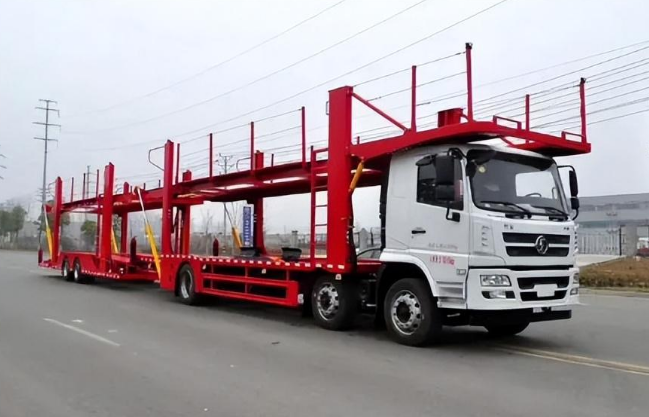trailer is a type of vehicle widely used in the domestic freight industry. Compared with other Semi Trailer Manufacturers' freight models, trailer has the characteristics of elevated transportation efficiency and low transportation cost. With the update of relevant standards, the requirements of trailer transportation are becoming more and more strict.
I. Definition of various types of trailers
1. Grid-type truck/semi-trailer
The structure of the loading part is cage type or fence type and separate from the cab of the truck/semi-trailer, the top of the loading part should be installed with the side fence fixed, can not be removed and adjusted ceiling rod.
2. Pallet truck/semi-trailer
A truck/trailer having a rail board structure at the loading site, including a rail board truck/semi-trailer having an on-board lifting device, but excluding a truck/trailer having an automatic tipping device.
3. Flatbed truck/semi-trailer
A truck/semi-trailer with a flat plate structure and no rail plate at the loading site.
 4. Dump truck/semi-trailer
4. Dump truck/semi-trailer
A truck/semitrailer with a rail-board structure and an automatic tipping device.
5. Special semi-trailer for low flat plate
Semi trailers that can not be dismantled for transport of large objects mainly have the following structural and technical characteristics:
The nominal section width of the tire shall not exceed 8.25in or 245mm;
the connection with the tractor is gooseneck type;
low cargo platform The height of the bearing surface of the cargo platform above the ground is no further than 1150mm.
6, high head semi trailer tractor
Semi-trailer tractors that also meet the following conditions:
More than half of the engine body is located in front of the front wind window glass.
The center of the steering wheel is located after the first quarter of the total length of the cab of the vehicle;
the center line of the front axle is located before the most anterior point of the front windpane.
7. High head hinge train
A hinged train consisting of a tall-headed semitrailer tractor and a semi-trailer.
8. Middle axle trailer
The traction device cannot move vertically, and the axle is located in the trailer close to the center of gravity of the trailer. This kind of vehicle has only a small vertical static load on the tractor, which is not more than 10% of the maximum mass of the trailer or 10000N load (whichever is smaller). One or more axes can be driven by the tractor.
9. Mid-axle vehicle transport trailer
A mid-axle trailer with a single or multiple deck for loading transport vehicles.
10. Mid-axle vehicle transport train
An automobile train consists of a freight car and a mid-axle trailer, having a single or multiple deck for loading transport vehicles.
11. Passenger car trains
A combination of a passenger car and a mid-axle trailer.
12. Freight train
A combination of a truck and a tractor-bar trailer or a mid-axle trailer.
13. Special operation vehicle
A device is a special equipment or appliance designed and built for a special operation, but does not include an automobile whose primary purpose is to carry people or goods.
2. Limit of outer profile size
Additional requirements on the dimensions of the vehicle's external profile: the unilateral extension of the indirect visual field device of the vehicle should not exceed the width of the vehicle by 250mm; the top window and ventilation device of the vehicle should not exceed the height of the vehicle by 300mm when the vehicle is opened; the distance between the rear axle of the vehicle and the front axle of the tractor-rod trailer should not be inferior than 3000mm.
For the outer profile size of the trailer, the allowable error range is ±1% or ±50mm under normal circumstances, that is, ≤1% or ≤50mm. Beyond this error range, it belongs to the category of violation.
In addition, the freight vehicle's empty weight error allowed range of ±3%, beyond this range will not be registered and will be reported as a violation of the product.
3. Total quality limit
According to GB1589 "Limits of Size, Axle Load and Mass of Automobile, Trailer and Automobile Train", the maximum allowable total mass limit of a one-axle semi-trailer is 18t, the limit of two-axle semi-trailer is 35t, and the limit of three-axle semi-trailer is 40t. The maximum allowable total mass limit of two-axle tractor-bar trailer is 18t; one-axle mid-axle trailer limit 10t, two-axle limit 18t, three-axle limit 24t; the maximum allowable total mass limit is 27 for three-axle automobile trains, 36t for four-axle automobile trains, 43t for five-axle automobile trains, and 49t for six-axle automobile trains.
Four, the maximum allowable axial load limit
Axle load refers to the load borne by the axle. About the load quality of the axle load, commonly indicated on the certificate of the vehicle, the force makes each tire can wear evenly, meet the main performance needs of the vehicle, but also take into account the layout of the vehicle, etc.
For different axle types, the maximum allowable axle load shall not exceed the number of axle tires multiplied by 3000kg.
If the owner's vehicle is some special operation vehicle, its size and load limit can be referred to the following table:
The maximum allowable load of each shaft is not more than 13000kg; the maximum allowable total mass shall not exceed 55000kg.
